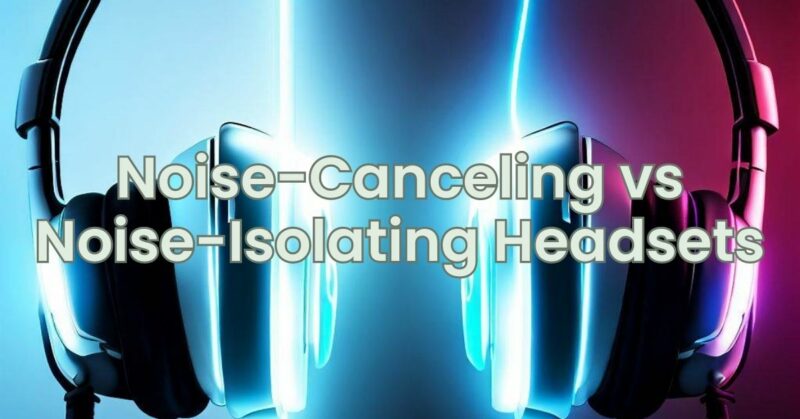When it comes to enjoying audio in noisy environments, noise-canceling and noise-isolating headsets are popular choices. These two technologies offer distinct approaches to reducing unwanted background noise, allowing you to immerse yourself in your audio. In this article, we will explore the differences between noise-canceling and noise-isolating headsets, helping you choose the right option based on your preferences and specific requirements.
- Noise-Canceling Headsets:
- Active noise cancellation (ANC): Noise-canceling headsets feature built-in microphones that capture external sounds. The headset then generates inverse sound waves to cancel out or reduce the incoming noise. This technology is particularly effective at reducing low-frequency continuous noises, such as airplane engines or office HVAC systems.
- Immersive audio experience: By actively canceling out background noise, noise-canceling headsets create a quiet and serene listening environment. This allows you to fully immerse yourself in your audio without distractions, enhancing the clarity and quality of your listening experience.
- Ideal for travel and noisy environments: Noise-canceling headsets are particularly beneficial for frequent travelers, commuters, or individuals working in noisy environments. They help create a more peaceful and enjoyable audio experience by reducing the impact of external disturbances.
- Noise-Isolating Headsets:
- Passive noise isolation: Noise-isolating headsets rely on physical design elements, such as snug-fitting ear cups or ear tips, to create a seal that blocks external noise. These headsets form a barrier between your ears and the surrounding environment, preventing sound from entering or escaping.
- Natural sound blocking: Noise-isolating headsets effectively block out a wide range of external noises, including both low and high frequencies. They provide a more natural and passive way of reducing unwanted sounds, allowing you to enjoy your audio without the need for active technology.
- Versatile and energy-efficient: Noise-isolating headsets do not require additional power or batteries since they rely solely on the design and fit. This makes them more versatile and suitable for long listening sessions without the need for recharging.
- Considerations for Both:
- Price: Noise-canceling headsets tend to be more expensive than noise-isolating ones due to the advanced technology involved.
- Audio quality: While noise-canceling technology can enhance audio clarity by reducing external distractions, some users may prefer the audio quality and sound signature of noise-isolating headsets, which don’t alter the audio through active cancellation.
- Battery life: Noise-canceling headsets require power to operate the active noise cancellation feature, which can impact battery life. It’s important to consider the duration of continuous usage and the charging time required.
- Fit and comfort: Both noise-canceling and noise-isolating headsets should provide a comfortable fit for extended wear. It’s essential to consider factors such as ear cup size, ear tip options, and overall ergonomics to ensure a comfortable and secure fit.
Here is a table summarizing the pros and cons of noise-canceling and noise-isolating headsets:
| Feature | Noise-Canceling Headsets | Noise-Isolating Headsets |
|---|---|---|
| Noise isolation | Effective at blocking out low-frequency noise | Effective at blocking out all frequencies of noise |
| Comfort | Can be uncomfortable to wear for long periods of time | More comfortable to wear for long periods of time |
| Battery life | Requires batteries | No batteries required |
| Price | More expensive | Less expensive |
Choosing between noise-canceling and noise-isolating headsets depends on your specific needs and audio preferences. Noise-canceling headsets excel at actively canceling out external noise, providing a serene and immersive audio experience in noisy environments. They are ideal for frequent travelers or individuals seeking a quieter audio environment. Noise-isolating headsets, on the other hand, rely on physical design elements to block out external noise naturally. They offer versatility, passive noise reduction, and a more budget-friendly option without compromising audio quality.
Consider factors such as your usage scenarios, desired level of noise reduction, audio quality preferences, and budget when making your decision. Testing different headsets and understanding your specific requirements will help you choose the option that best aligns with your needs. Regardless of your choice, both noise-canceling and noise-isolating headsets offer solutions to enhance your audio enjoyment by minimizing unwanted background noise and immersing you in your favorite sounds.


